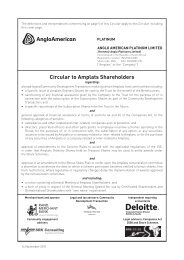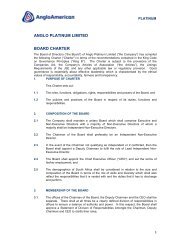Operations Review (Part 1) - Anglo Platinum
Operations Review (Part 1) - Anglo Platinum
Operations Review (Part 1) - Anglo Platinum
- No tags were found...
Create successful ePaper yourself
Turn your PDF publications into a flip-book with our unique Google optimized e-Paper software.
<strong>Operations</strong> <strong>Review</strong>Location of Group <strong>Operations</strong>Rustenburg Section, the largest of the mining operations, contributed 29,1% of the platinum ounces produced,Amandelbult Section 31,6%, Union Section 12,6%, Potgietersrust <strong>Platinum</strong>s (PPRust) 7,3% andLebowa <strong>Platinum</strong> Mines (Leplats) 4,6%. Bafokeng-Rasimone <strong>Platinum</strong> Mine (BRPM), which is building up tofull production, contributed 7,2%. In addition, Modikwa <strong>Platinum</strong> Mine accounted for a further 1,1% and theRustenburg UG2 Phase 1 Project for the balance of 6,5%.34
Flow ChartMINING, TREATMENT & REFINING PROCESSBelow Ground MiningWasteAbove Ground MiningWasteConcentratorsTailingsMillingFiltrationFlotationMetallicsCo SO 4Final concentrateDissolveValues recovery plantProcessingPure metal productsSodiumSulphatePrecious Metal RefineryM C PlantNi/Cu/CoConcentrateMedium grade residueConverter matteMetals & SaltsCuNiPtPdIrAuRuConcentrateLow grade residueLow grade residueBase Metal RefineryLeachingProcessingElectro-winningSmeltersConvertingMedium grade residue Sulphuric acidOsRhSmeltingSlagThe Process Division consists of the WatervalSmelter complex, the Rustenburg Base MetalsRefinery (RBMR) and the Precious Metals Refinery(PMR). The process plants produce the Group’srefined precious and base metals.35
<strong>Operations</strong> <strong>Review</strong> (continued)Chief Operating Officer’s <strong>Review</strong>The ultimate goal of a fatality-free working environment will only be achieved through a mind-shiftchange in behaviour.I am happy to report that satisfactoryprogress was achievedon several fronts. Aside froma concerted and indeedsuccessful effort to containunit costs at steady-stateoperations in line with therate of inflation, the yearculminated in confirmation ofthe production profile necessaryto achieve our expansion to3,5 million annual ounces ofplatinum by the end of 2006.The structure of theoperational strategy, asI outlined last year, hasenabled labour and managementto focus successfully onbusiness performance, therebyaligning the <strong>Operations</strong> withthe Group’s strategy.S A F E T YUnder the guidance of theGroup’s Safety, Health andEnvironment (“SHE”)committee, a committee of theBoard, the Group embarked thispast year on the most intenseand focused safety programmesin its history. The success ofthese programmes is evident ina marked reduction in thereported lost-time injuryfrequency rate per 200 000hours worked (“LTIFR”),which now stands at 1,2; animprovement of 54% on 2001.Notwithstanding the improvement,the Board regrets toreport the death of26 employees at managedoperations during the year.Management will continue toimplement and apply all safetyprogrammes in a determinedmanner.The ultimate goal of a fatalityfreeworking environment willonly be achieved through amind-shift change in behaviour.36Training at the Fireand Rescue Departmentat Rustenburg Section.
To this end, I am pleased toreport that the implementationDorian EmmettChief Operating Officerof the Behaviour-Based Safety(BBS) process, whichemphasises the need fordesirable behaviour andpublicly recognises acts ofsafe behaviour, hascontributed to the drop in theLTIFR. I am confident that intime the BBS process willpermeate every aspect of ourdaily routine as we strive toeliminate all unsafe acts.Please refer to the SustainableDevelopment Report(Volume 2) for a detailedoverview of the manysuccessful environmentaland socio-economic initiativesundertaken over the year anda more complete summary ofhealth and safety.C O M P E T I T I V E C O S TP E R F O R M A N C E<strong>Operations</strong>An operating margin of 54,5%was achieved on steady-stateoperations. AmandelbultSection performed solidly.Head grade and concentratorrecovery both improved andthe unit cost increase wascontained to 9,6%. Lebowaalso performed well in 2002and raised its production,head grade and concentratorrecovery. Unit costs rose by10,7%. Union Sectionmaintained production levelsdespite losing shiftsassociated with the evaluationof a new employee shiftsystem in co-operation withunions and associations.The mine focused onupgrading infrastructure andincreasing available orereserves. Unit costs rose by12,1%. Rustenburg Section’sreported production declinedprincipally as a result ofthe incorporation of theBrakspruit, Bleskop andPaardekraal shafts in theRustenburg UG2 Phase 1project. Costs on the smallerbase were well controlled.In the first half of the yearPotgietersrust was negativelyaffected by a drop in millhead grade resulting from alow-grade intrusion in thesouth pit. An acceleratedstripping programme,additional production from anew mini-pit and completionof the Ga-Pila villagerelocation during the yearresulted in an increase inavailable ore reserves by yearend, enhancing future miningflexibility. Costs were wellcontrolled; the cash costper ton mined fell 16,0%compared to 2001. However,the unit cost per refinedounce increased by 43,7% asa result of the lower grade.The smelting, treatment andrefining operations deliveredan excellent performancein terms of throughput,recoveries and pipeline stockmanagement during 2002.The hiring of the additionalfurnace to treat high chromeslag arisings will cease oncommissioning of a new slagcleaning furnace in the secondquarter of 2003.37
<strong>Operations</strong> <strong>Review</strong> (continued)Chief Operating Officer’s <strong>Review</strong>H U M A N R E S O U R C E A N DO R G A N I S A T I O N A LD E V E L O P M E N THuman resource development (HRD) isa core component of <strong>Anglo</strong> <strong>Platinum</strong>’sHR and Group strategy. HRD plansare continually integrated with thebusiness plan, assessed, reviewedand revised. They cover the short-,medium- and long-term human capitaldevelopment commitments of theorganisation.In line with the theme of Lasting<strong>Platinum</strong> Prosperity, <strong>Anglo</strong> <strong>Platinum</strong> setnew standards in the transformation ofbusiness in South Africa when theEmployee Relations Policy was signedin March 2002. The policy embraces allinternal and external employeerelations, issues and activities, andallows all stakeholders, from seniormanagement to junior employees, tobe represented in partnership forumsand the Collective Bargaining Forum.In August, in accordance with thisprocess, all parties to the CollectiveBargaining Forum reached anagreement on wages and substantiveconditions of employment for atwo-year period ending 30 June 2004.This agreement, I am proud to report,is the first ever to be concluded ina central bargaining process involvingall nine union parties and lays thefoundation for two years of industrialcooperation.Maintainance crews workingthrough the night at theWaterval Concentrator.The Group’s second annualemployment equity progress reportwas presented to the Departmentof Labour in 2002. All businessunits now have an employment equitycommittees representing management38
and employees, which are fullyrepresentative and chaired bythe business managers.Furthermore, senior and middlemanagers at most of thebusiness units underwent transformationtraining, withparticular focus on managingdiversity, teamwork andperformance optimisation.As the Group participatesin more joint ventures, thistraining will increase inimportance.The expansion will create asignificant number of newemployment positions between2002 and 2006, bringing withPRODUCTION Pt oz (000’s)Full marginRefinery margin onlyBUILD UPDURATION0202030304040505060657Production forecastit challenges for recruitment,training and development andthe need for proper talentmanagement. To facilitate this,a Group HR plan has beendeveloped and a specialistrecruitment function hasbeen established within theProjects Division.Please refer to Volume 2, theSustainable DevelopmentReport for an in-depth reviewof HRD.P G M P R O D U C T I O NThe planned build-up ofproduction to a rate of07 083 5003 0002 5002 0001 5001 000BRPMModikwaRPM UG2 Ph1TwickenhamRPM TailingsJV’s & other3,5 million refined platinumounces by the end of 2006 wasaffected as a result ofdifficulties experienced withthe Department of Minerals andEnergy (DME) in processingapplications for mining authorisations.After re-planning anew production profile wasannounced in November 2002.Providing no further delays areexperienced in the processingof applications, an annualproduction rate equivalent to3,5 million refined platinumounces can still be achieved bythe end of 2006.An agreement has been signedwith the DME which will bothsecure the granting of themining authorisations necessaryto achieve the planned build-upand satisfy the requirements ofthe Mineral Resources Act andCharter.<strong>Part</strong> of the agreement reachedwith Government involved theTwickenham and Der Brochenprojects areas on the EasternLimb. It is envisaged thatempowerment groups holdingmineral rights adjacent to eachproject area will contributethose rights to the respectiveprojects. A 50:50 joint venturebetween the empowerment39
<strong>Operations</strong> <strong>Review</strong> (continued)Chief Operating Officer’s <strong>Review</strong>0 50kmLEGENDBushveld ComplexMining AuthorisationAuthorisation PendingLEBOWA PLATINUM MINETWICKENHAMPLATINUM MINEPROJECTMODIKWAPLATINUMMINEEASTERN LIMBDer BrochenProjectLydenburgMPUMALANGAPROVINCEWitbank40
group and <strong>Anglo</strong> <strong>Platinum</strong>will then be established overa discrete portion of eachproject area, while theremainder of each projectarea will be developed as a100% <strong>Anglo</strong> <strong>Platinum</strong> project.In the case of Twickenham,the empowerment jointventure is referred to as thePaschaskraal joint venture andthe <strong>Anglo</strong> <strong>Platinum</strong> 100%owned venture as theTwickenham project, whilethe Der Brochen projectarea refers to the 100%owned <strong>Anglo</strong> <strong>Platinum</strong>project and the Booysendaljoint venture to theempowerment jointventure.In concluding these agreements,<strong>Anglo</strong> <strong>Platinum</strong> was‘credited’ for contributingmore than 26% of metalproduction to the venture.As a result of these credits,the Group will have satisfiedits empowerment requirementson any expansions it maywish to undertake atPPRust.The new production profile,illustrated in the chartson page 39, while mitigatingthe impact of miningauthorisationdelays, results in anumber of projects commissioningonly in 2005 and 2006.For a more detailed reviewon each project, I refer you tothe Overview: Projects onpage 52.R E T U R N O N E Q U I T Y( R O E )Given the size of <strong>Anglo</strong><strong>Platinum</strong>’s expansion, and thecapital programme required tofund it, the timing of capitalexpenditure has a criticalimpact on the Group’s ROE.Given this, a concerted effortaimed at enhancing efficiencieswithin the operations, recognisedas the Continuous BusinessImprovement (CBI) initiative,previously known as ‘ProjectBreakthrough’, continued to beactive in 2002 with theimplementation of programmesfocused on improving theperformance of the coreprocesses within the business.Mining optimisation, mechanisationand concentratoroptimisation, the threemajor thrusts of CBI,have all contributed toenhancing our businessprocesses and I am confidentthat this initiative will help keepunit cost increases at our steadystateoperations at or below theinflation rate.O U T L O O K F O R 2 0 0 3The production target for 2003is 2,4 million ounces ofplatinum. The Group as a wholewill face many challenges,which I am confident we willmeet. I wish to thank the<strong>Operations</strong> Committee and eachindividual at all our operationsfor your commitment anddedication during the past year,and I look forward to workingwith you to making 2003 asafe and productive year.Dorian EmmettChief Operating OfficerJohannesburg27 March 200341
<strong>Operations</strong> <strong>Review</strong> (continued)Overview: MiningRustenburg SectionS A F E T Y53The Rustenburg business unit achieved its 37th million fatality-free shift on 18 December2002. Paardekraal and Boschfontein shafts on the West Mine were recommended forOSHAS18001 certification, while the Central Services Sectionobtained 2 million fatality-free shifts on 18 December 2002.Safety initiatives started in 2001, as well as the new BBSinitiative, continue to reinforce management’s commitmentto safety.M I N I N GRustenburg Section’s reported production declined principally asa result of the incorporation of the Brakspruit, Bleskop andPaardekraal shafts in the Rustenburg UG2 Phase 1 project.Costs on the smaller base were well controlled.The UG2 Phase 1 project consists of a 400 000 tons per monthconcentrator processing ore from the new Waterval mine as wellas the Brakspruit, Bleskop and Paardekraal shafts. <strong>Operations</strong>commenced in February 2002.Bleskop Shaft mechanised(trackless) bord and pillar operations.Methane testing ahead offace drilling utilising a new singleboom drill rig in a well controlled1,8 metre stoping environment.RPM-RUSTENBURG SECTION123456789LEGENDMining AuthorisationMerensky Reef WorkingsUG2 Reef WorkingsUG2 Phase II DevelopmentBoschfontein Incline ShaftTownlands ShaftPaardekraal ShaftFrank No.2 ShaftFrank ShaftWaterval ShaftCentral Deep ShaftTurffontein ShaftBleskop ShaftBOSCHFONTEIN1268 JQTOWN &TOWNLANDS2272 JQ0 5kmPAARDEKRAAL279 JQ3WATERVAL303 JQ654KLIPGAT281 JQ7KROONDAL304 JQTURFFONTEIN302 JQ8KLIPFONTEIN300 JQ9HOEDSPRUIT298 JQ10BRAKSPRUIT299 JQ10Brakspruit Shaft43
<strong>Operations</strong> <strong>Review</strong> (continued)Overview: MiningAmandelbult SectionS A F E T Y53Amandelbult Section achieved one million fatality-free shifts on 25 March 2002and 2 million fatality-free shifts on 8 August 2002. Despite these landmarkachievements, two fatalities were recorded in themonth of October 2002. A 57% year-on-year drop inthe LTIFR, a 13% fall in the serious injury frequencyrate and an 80% improvement in the fatal injury ratewere nevertheless achieved for the year.The emphasis on safety was boosted by the BBSinitiative, backed by underground training anddevelopment promoting best practice.M I N I N GAmandelbult Section performed solidly. Head grade andconcentrator recovery both improved and the unit costincrease was contained to 9,6%.Roof bolter entering theAmandelbult 16 West Decline,a trackless mining operation.RPM-AMANDELBULT SECTIONZWARTKOP369 KQMODDERGAT389 KQ1ELANDSFONTEIN386 KQMIDDELLAAGTESCHILPADNEST382 KQ385 KQAMANDELBULT383 KQ2ELANDSKUIL378 KQHAAKDOORNDRIFT374 KQGOEVERNEMENTS-PLAATS417 KQ0 5kmLEGENDMining AuthorisationMerensky ReefUG2 ReefMerensky Reef WorkingsUG2 Reef Workings1 No.1 Shaft2 No.2 Shaft44
Union SectionS A F E T Y53Union Section achieved 1 million fatality-free shifts in August 2002 and the surfacesection has achieved more than 5 million fatality-free shifts.Despite these milestones and a lower LTIFR, three fatalities wererecorded in 2002, one fewer than in 2001. The mine has everyconfidence that the recent BBS initiative will help lead to aneven better safety performance in 2003.M I N I N GUnion Section maintained production levels despite losing shiftsassociated with the evaluation of a new employee shift systemin co-operation with unions and associations. The mine focusedon upgrading infrastructure and increasing available orereserves.The low-profile mechanised decline system established on theUG2 horizon has continued to meet its build-up targets, raisingthe amount of ore produced from lower-cost mining at UnionSection.A new technology multi axisbolter being controlled remotelyby an operator at Union Section’sdevelopment drive – Decline 4B.RPM-UNION SECTIONZWARTKLIP405 KQ1GROOTKUIL409 KQTURFBULT404 KQ324SPITSKOP410 KQLEGENDMining AuthorisationAuthorisation PendingHAAKDOORN6 KQ SYFERKUIL9 KQMerensky Reef WorkingsUG2 Reef Workings1 Ivan Shaft2 Richard Shaft322 Vertical Shaft0 5km4Spud Shaft45
<strong>Operations</strong> <strong>Review</strong> (continued)Overview: MiningPotgietersrust <strong>Platinum</strong>s (PPRust)S A F E T Y53Safety performance over the past four years has seen a dramatic improvement and all 2002safety objectives were achieved. The BBS initiative continues to underpin ownership ofsafety issues. Two years have now passed without a fatal orreportable accident.M I N I N GIn the first half of the year Potgietersrust was negativelyaffected by a drop in mill head grade resulting from a low-gradeintrusion in the south pit. An accelerated stripping programme,additional production from a new mini-pit and completion of theGa-Pila village relocation during the year resulted in an increasein available ore reserves by year end, enhancing future miningflexibility. Costs were well controlled; the cash cost per tonmined fell 16,0% compared to 2001. However, the unit costper refined ounce increased by 43,7% as a result of thelower grade.Rosina Mahlatji, a wheel-dozeroperator, preparing for a day’s workat PPRust’s opencast operation.OVERYSEL815 LRPOTGIETERSRUST PLATINUMS LIMITED12ZWARTFONTEIN818 LR3VAALKOP819 LRLEGENDMining AuthorisationPlatreef Pit45TWEEFONTEIN238 KRPlatreefMajor Fault1 Overysel Central*2 Zwartfontein North*SANDSLOOT236 KRKNAPDAAR234 KRRIETFONTEIN240 KR63 Zwartfontein South*4 Sandsloot Pit5 Tweefontein North*6Tweefontein Hill**Future Pits0 5km46
Lebowa <strong>Platinum</strong> Mines (Leplats)S A F E T Y53The BBS initiative resulted in greater safety during 2002, although it is distressingto report that three fatalities nevertheless occurred, up from one in 2001.The LTIFR dropped from 1,14 to 0,53 and the year ended on halfa million fatality-free shifts.M I N I N GLeplats performed well in 2002 and raised its production, headgrade and concentrator recovery. Unit costs rose by 10,7%.LEBOWA PLATINUM MINES LIMITEDZEEKOEGAT 421 KSMiddelpunt HillDIAMAND422 KSLEGENDMining AuthorisationMIDDELPUNT420 KS2134UMKOANESSTAD419 KSBRAKFONTEINBRAKFONTEIN464 464 KSMerensky Reef WorkingsUG2 Reef WorkingsMerensky ReefUG2 Reef1 Vertical Shaft2 Middelpunt Adits3 UM1 Incline0 5 km4UM2 Incline47
<strong>Operations</strong> <strong>Review</strong> (continued)Overview: MiningBafokeng-Rasimone <strong>Platinum</strong> Mine (BRPM)S A F E T Y53Several safety milestones were achieved during the year on the back of the BBSinitiative pursued in line with <strong>Anglo</strong> <strong>Platinum</strong>’s rigorous policy on safety. In addition,dedicated on-mine training facilities, both undergroundand on surface, were fully established. Two fatalitiesoccurred at the mine during 2002.M I N I N GThe mine continued to increase development andimprove mining efficiencies during 2002, despite difficultgeological conditions at South Shaft. Tons milled fromunderground operations were increased by 81,9% to1,85 million tons. Refined production rose by 24,5%compared to 2001, and the mine added R433,9 million tothe Group’s operating contribution.Miners starting their descent towork on the declines conveyorbelt system at BRPM North Shaft.STYLDRIFT 90 JQ1BOSCHKOPPIE104 JQLEGENDMining AuthorisationMerensky ReefUG2 ReefMerensky Reef PitUG2 Reef PitMerensky Reef WorkingsFault1 North Incline2 2 South Incline3 D-Mine Incline30 1 2km48BAFOKENG-RASIMONEPLATINUM MINE
<strong>Operations</strong> <strong>Review</strong> (continued)Overview: ProcessingSmelter <strong>Operations</strong>S A F E T Y53Waterval Smelter achieved a lost-time injury rate that was among the best in theworld for smelting operations. A BBS initiative was implemented in the latter half ofthe year, encouraging all employees to adopt a positive attitudetowards safety and to ensure that co-workers perform theirduties safely.S M E L T I N GWaterval Smelter receives concentrate from the miningoperations, as well as furnace matte from the Union Sectionsmelter. These feed products are treated to produce a convertermatte amenable to further processing at the RBMR.The smelter performed well, with a record amount of bothconcentrate being treated and PGMs being passed to therefineries. The continued use of a third-party furnace enabledthe plant to return higher recoveries of metals while assisting inthe rejection of chrome from the circuit. The hiring of theadditional furnace will cease on commissioning of a new slagcleaningfurnace.The new converting plant was officially opened during thecourse of the year and is presently undergoing commissioning.The benefits in reduced emissions from the smelter aresignificant and the completion of the optimisation phase isexpected in early 2003.Hot commissioning of the slag-cleaning furnace is expected tostart in the first quarter of 2003. This unit will take over the roleof rejecting chrome from the various streams, while at the sametime improving operating efficiencies.Unit costs were contained within the inflation rate at the Smelteritself. While the hiring of the additional smelter addedR112,1 million to costs, causing the cash smelting, treatmentand refining cost per refined platinum ounce to rise by 19,1%,the increased production volumes generated by higher metalrecoveries contributed revenues which far outweighedthese costs.49Contractors nearing completionof a new furnace at WatervalSmelter.
<strong>Operations</strong> <strong>Review</strong> (continued)Overview: ProcessingRustenburg Base Metals Refiners (RBMR)S A F E T Y53The LTIFR declined 40% to 0,29 in 2002. Despite this improvement, a fatalityoccurred in January 2002. The BBS initiative continued, with over 50% of personneltrained so far; this programme has also contributed toimproved employee relations across the site.B A S E M E T A L S R E F I N I N GRBMR processes Waterval Converter Matte (WCM) toproduce a precious metals concentrate, for furtherrefining at the PMR, and quality base metal final productsfor sale to customers.The two metallurgical operations, the magneticseparation plant (MC Plant) and the base metal refinery,performed well over the year with both achieving <strong>Anglo</strong><strong>Platinum</strong> record throughputs for precious and base metalsduring the year.The de-bottlenecking of the two metallurgical plants,The new steam generationfacilities at the Base MetalsRefinery have state-of-the-artlow emission designs in order toachieve excellent environmentalcompliance.the MC Plant and the Base Metal Refinery, continuedon schedule, facilitating treatment for the plannedexpansion of precious and base metals.Virtually no emissions will leavethe new steam generation facilityat RBMR’s coal fired boiler stack.50
Precious Metals Refiners (PMR)S A F E T Y53No lost-time injuries were recorded in 2002 and the PMR’s fatality-free record remains inplace. A NOSA 5-star rating was maintained for the twelfth consecutive year and PMR wasawarded the prestigious and internationally recognised NOSCAR safety award for the eighthconsecutive year.In addition, a BBS initiative was launched and is currently at anadvanced stage of implementation.P R E C I O U S M E T A L S R E F I N I N GLocated in Rustenburg, the PMR, in terms of size, technology andrecoveries, remains the world leader in the field of PGM refining.Refining services are provided for all Group mines and associatedjoint ventures.Final concentrate from the MC Plant at RBMR and metallicconcentrates from four mine concentrators are refined to highdegrees of purity and fabricated into various product forms tomeet customer requirements.Production of all metals during 2002 was higher than the previousyear as a result of increased volumes from upstream operations.Recoveries were the best recorded in PMR’s operating life andwork in progress was the lowest measured since start up in 1989.The PMR capacity expansion project (refer to the Overview ofProjects on page 58) is well advanced and construction hascommenced as planned.Tapping platinum powder intothe melting furnace at PMR forthe casting of platinum bars.Checking critical temperaturereadings on the recently installedglass vessel section at PMR(installed to increase capacity ofexisting equipment).51
<strong>Operations</strong> <strong>Review</strong> (continued)Overview: ProjectsThe Projects Division, established in 2001, is responsible for the feasibility study, evaluationand execution of the major expansion projects required to meet the 2006 target of3,5 million annual ounces of platinum.During the year, in pursuit of the expansion objectives, theRustenburg Tailings Retreatment Project and a further expansion(Phase 2) to the Rustenburg UG2 project were announced.The Board approved, after year end, the joint venture withLonmin <strong>Platinum</strong> (the Pandora Project) to exploit the UG2reserves west of Brits. A portion of the project will be allocatedto empowerment partners.Agreement was reached with Government on several key miningauthorisations on the Eastern Limb of the Bushveld Complex.There will be four separate project areas, two of which will bedeveloped 100% by <strong>Anglo</strong> <strong>Platinum</strong>, these being Twickenhamand Der Brochen, and two adjacent projects, being Paschaskraaland Booysendal respectively, will be 50:50 joint ventures withempowerment consortiums.Further mining opportunities continue to be evaluated, both forthe purposes of Group expansion and replacement of depletedA training session at the<strong>Anglo</strong> <strong>Platinum</strong> DevelopmentCentre (ADC) in Rustenburg.reserves at existing operations. Additional mining projects willbe announced during 2003. Also, de-bottlenecking ofprocessing capacity will be necessary; option evaluation iswell-advanced and processing project announcements will bemade in 2003.S A F E T Y53A strong emphasis has been placed on safety in all project execution activities, traditionallya high-risk area. During 2002, in excess of 25 million man-hours were worked. There werea total of 30 lost-time injuries for the year, resulting in a world-class performance frequencyrate of 0,24, a drop of 18% on 2001. The division regrets the occurrence of three fatalities,two of which were caused by falls of ground.The strong support received from contracting companies in the area of safety is encouraging.52
M I N I N G P R O J E C T S U N D E R C O N S T R U C T I O NCapitalexpenditure,real 2003PlannedDate Scheduled terms steady-stateapproved completion R millions productionModikwa <strong>Platinum</strong> February Plant:Mine 2000 2002 1 800 200 000 tons p.m.Full production:162 000 oz Pt p.a.2004 146 000 oz Pd p.a.Rustenburg UG2 September Plant:Expansion, Phase 1 2000 2002 1 500 400 000 tons p.m.Full production:395 000 oz Pt p.a.2006 197 000 oz Pd p.a.Twickenham September Plant:<strong>Platinum</strong> Mine 2001 2005 3 200 250 000 tons p.m.Full production:160 000 oz Pt p.a.2007 176 000 oz Pd p.a.Rustenburg Tailings October Plant:Retreatment 2002 2004 1 600 900 000 tons p.m.Full production:120 000 oz Pt p.a.2006 38 000 oz Pd p.a.Rustenburg UG2 November Plant:Expansion, Phase 2 2002 2005 3 700 400 000 tons p.m.Full production:306 000 oz Pt p.a.2007 167 000 oz Pd p.a.Metallurgists takingsamples from theACP pollution controldam with ACP buildingsand plant in background.53
<strong>Operations</strong> <strong>Review</strong> (continued)Overview: ProjectsModikwa <strong>Platinum</strong> Mine; joint venture with African Rainbow Minerals (ARM)Safety: Modikwa recorded a safety performance better than planned for both lost-timeand reportable injuries. This was achieved with mainly a novice workforce sourced from thelocal community. From inception, Modikwa’s safety effort hasbeen based on the BBS initiative. One fatality was recorded.Mining: The concentrator was commissioned in the second halfof the year and achieved the design throughput of 200 000 tonsper month in September 2002. Recoveries were better thanplanned. The initial stoping performance has been pleasing, andthe build-up in ounces produced is in line with the very hightargets set for this project.Modikwa has been successful in employing mainly localpersonnel where possible.A view of the new robotequipped laboratory on trial at<strong>Anglo</strong> <strong>Platinum</strong>’s Research Centrebefore being moved to theModikwa <strong>Platinum</strong> Mine. Roboticswill be used extensively in allnew laboratory facilities.DRIEKOP253 KTMAANDAGSHOEK254 KTLEGENDMining AuthorisationUg2 Reef WorkingsMerensky ReefUG2 Reef1 Maandagshoek Winze2 North Shaft (Decline)3 Mid Shaft (Decline)4 South Shaft (Decline)5 Onverwacht Hill (Adits)1HENDRIKSPLAATS281 KT2 345ONVERWACHT 292 KTWINTERVELD0 5km293 KTMODIKWA PLATINUM MINERustenburg Section UG2 ExpansionThe Rustenburg UG2 Phase 1 Project, announced in 2000,includes a 400 000 tons per month concentrator, processing orefrom the new Waterval mine, as well as the Brakspruit, Bleskopand Paardekraal shafts. The concentrator was successfullycommissioned as planned in February 2002 and performed well,achieving designed recoveries. The production build-up from theWaterval mine has been steep, but was slower than expecteddue to delays in development caused by congestionunderground. Stoping widths in the UG2 areas of the Brakspruit,Bleskop and Paardekraal shafts were increased toinclude the leader seam and reduce the risk offalls of ground, causing a reduction in headgrade. Test work has been done to provemethods of improving the mill feed grade, withimplementation to take place during 2003.The project added R451,4 million to the Group’soperating contribution for the year under review.Recently, the Group announced Phase 2 of theRustenburg UG2 project being a replacementproject for existing production rather than anexpansion. The new Waterval UG2 Concentrator54
will be doubled in capacity to 800 000 tons per month. The mining part of the project willexploit the UG2 reef at the existing Frank and Townlands vertical shafts to produce155 000 tons per month, and two new decline shafts will be established at BoschfonteinEast and Boschfontein West to produce an extra 245 000 tons per month. The projectis expected to cost some R3,7 billion in 2003 money terms andwill reach full production in 2007.Twickenham <strong>Platinum</strong> MineAn empowerment consortium was allocated mineral rightsadjacent to the original project area and will contribute theseto the project. A 50:50 joint venture will be established overa portion of the area (Paschaskraal and Klipfontein), nowknown as the Paschaskraal joint venture. The remainder of theproject area (Twickenham and Hackney), now known as theTwickenham <strong>Platinum</strong> Mine, will be developed and owned 100%by <strong>Anglo</strong> <strong>Platinum</strong>.In December 2002, mining authorisation was granted forthe Twickenham <strong>Platinum</strong> Mine. Trial mining operations areunderway and full site establishment was recently completed.Final mine designs, production rates and funding requirementsare being evaluated, in conjunction with the JV consortiumwhere applicable.Industrial theatre at Modikwa<strong>Platinum</strong> Mine.TWICKENHAM PLATINUM MINE PROJECT0 5kmTWICKENHAM114 KT SURBITON115 KTBALMORAL508 KSHACKNEY116 KT1FOREST HILL117 KT1LEGENDMining AuthorisationMerensky ReefUG2 ReefMain Portal55
<strong>Operations</strong> <strong>Review</strong> (continued)Overview: ProjectsRustenburg Tailings RetreatmentThe tailings plant will be situated near the Brakspruit shaft and will draw feedstock from anumber of tailings dams in the Klipfontein and Waterval areas. Capital expenditure isestimated at R1,6 billion in 2003 money terms. The plant is expected to commence operationin 2004, reaching full production in 2006 at an average rate of120 000 ounces of refined platinum and 38 000 ounces ofpalladium per annum. At the planned production rate, theproject’s resource base is sufficient to sustain production forsome 15 years.Styldrift (BRPM Expansion); joint venture with Royal BafokengNation (RBN)Preliminary design and project engineering work progressed wellin 2002, including a 3D seismic survey and scoping studies forthe Environmental Management Programme (EMP). Site accessremains on hold pending the outcome of negotiations with thejoint venture partner, the RBN, on optimising the mine design.Pandora; joint venture with Lonmin <strong>Platinum</strong>Instructor J Seraiseconducting temporary supportinstallation and barring training.The Pandora project to exploit the UG2 reserves west of Britswas approved by the <strong>Anglo</strong> <strong>Platinum</strong> Board and the joint ventureagreement has been signed with Lonmin <strong>Platinum</strong>. The projectwill have mineable UG2 reserves and resources in excess of130 million tons and is expected to produce 230 000 annualounces of refined platinum per annum over its expected life of30 years. A portion of the project will be allocated toempowerment partners: the Bapo Ba Mogale Tribe and Northam.f fLEGENDProject AreaMerensky ReefUG2 ReefFaultfPANDORA JVfROODEKOPJES 417 JQHARTEBEESTPOORT "B" 410 JQUITVALGROND 416 JQfff0 5kmf56
P R O C E S S I N G P R O J E C T S U N D E R C O N S T R U C T I O NCapitalexpenditure,real 2003PlannedDate Scheduled terms steady-stateapproved completion R millions production<strong>Anglo</strong> <strong>Platinum</strong> July Phase A:Converting Process 2000 2003 1 800* 72 000t matte p.a.(ACP) Phase B: 33 000t Ni p.a.2004 3,5Moz Pt p.a.Polokwane Smelter December 650kt2000 2003 1 500 concentrate p.a.Slag-cleaning FurnaceJuly(Waterval Smelter) 2001 2003 270 —PMR Expansion May 2002 2005 1 500 3,5Moz Pt p.a.*refers to Phase A and B.<strong>Anglo</strong> <strong>Platinum</strong> Converting Process (ACP)The objectives of the ACP project were to improve the control of sulphur emissions and, inso doing, achieve a new global benchmark, while providing converter capacity for theGroup’s expansion programme. Developed in conjunction with Ausmelt and others, the plantutilises a Sirosmelt process adapted to the requirements of nickel-copper matte smelting.This innovative technology was extensively tested during the project design and studyphase. This has led to the very successful results of trial smelting carried out as part of thecommissioning of Phase A that began in March 2002. Progress is continuing according toplan and it is anticipated that the ACP will be fully operational by the end of 2003. Theexisting convertors and the acid plant will be retained on standby during the construction ofthe second ACP reactor, Phase B, which is scheduled to be commissioned during 2004.Opening the new Ausmeltfurnace taphole with an oxygenlance to remove converter matteat the <strong>Anglo</strong> <strong>Platinum</strong> ConvertingProcess (ACP) in Rustenburg.
<strong>Operations</strong> <strong>Review</strong> (continued)Overview: ProjectsPolokwane SmelterSite activities commenced in early November 2001. The smelter is now substantiallycomplete and commissioning has commenced.Slag-cleaning Furnace (Waterval Smelter)Under normal practice, slag is returned to the primaryconcentrate-smelting electric furnaces to recover containedmetal values. However, with the rising amount of UG2concentrates being treated, the recycling of chromecreates constraints in the furnaces due to the elevatedmelting point of the slag. The project has been designed toalleviate this condition, raise the recovery of the containedmetal values and create additional capacity in the primaryfurnaces.PMR ExpansionThe PMR is undergoing de-bottlenecking to enable theGroup’s 2006 target of 3,5 million annual ounces ofplatinum to be met. Construction commenced on the GoldRapid progress has been madein the construction of the newPolokwane Smelter.Solvent Extraction and Insoluble Metals plants inDecember 2002. Earthworks are complete and civilsconstruction has started. The final phase of the debottleneckingwill be completed by the end of 2005.58


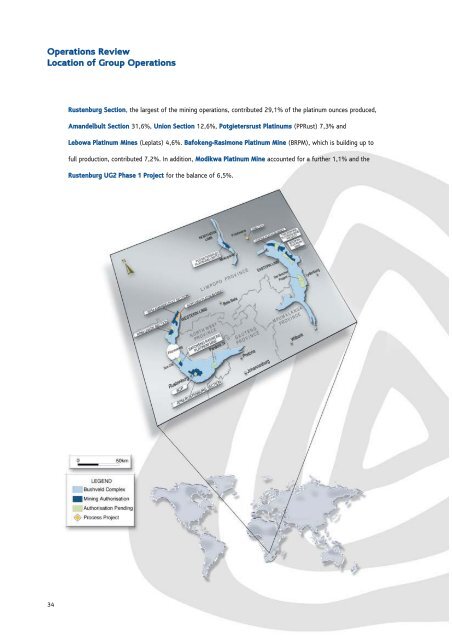
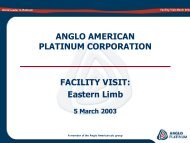
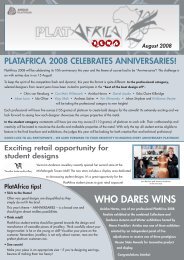
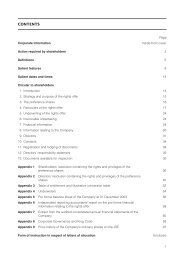


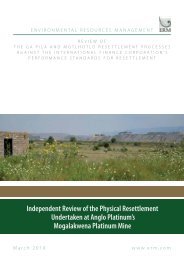

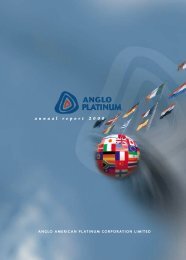
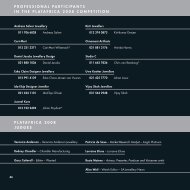
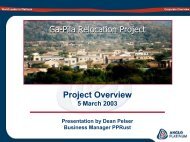
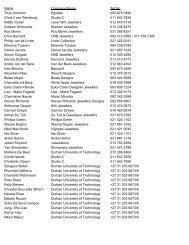
![[PDF] Mogalakwena Mine - Anglo Platinum](https://img.yumpu.com/43065142/1/184x260/pdf-mogalakwena-mine-anglo-platinum.jpg?quality=85)
